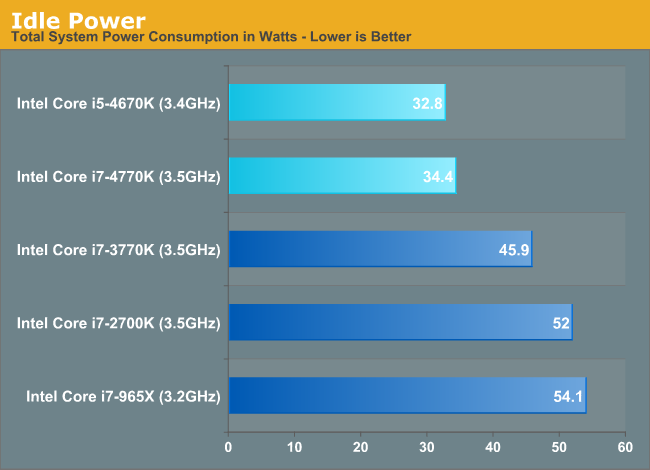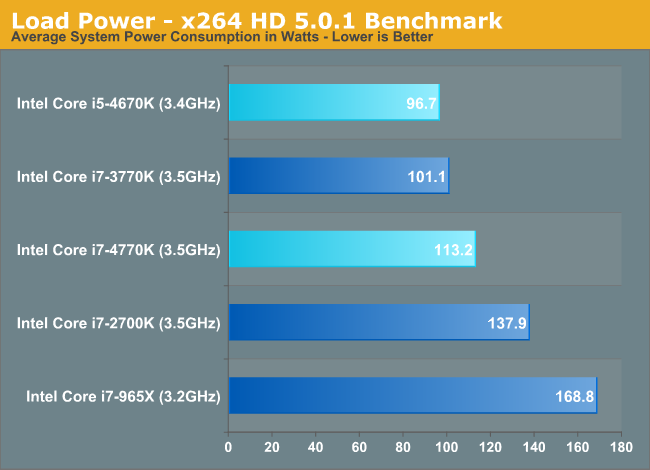The Haswell Review: Intel Core i7-4770K & i5-4670K Tested
by Anand Lal Shimpi on June 1, 2013 10:00 AM ESTPower Improvements
Although Haswell’s platform power is expected to drop considerably in mobile, particularly with Haswell U and Y SKUs (Ultrabooks and ultrathins/tablets), there are benefits to desktop Haswell parts as well.
There’s more fine grained power gating, lower chipset power and the CPU cores can transition between power states about 25% quicker than in Ivy Bridge - allowing the power control unit to be more aggressive in selecting lower power modes. We’ve also seen considerable improvements on lowering platform power consumption at the motherboard level as well. Using ASUS’ Z77 Deluxe and Z87 Deluxe motherboards for the Haswell, Ivy and Sandy Bridge CPUs, I measured significant improvements in idle power consumption:

These savings are beyond what I’d expect from Haswell alone. Intel isn’t the only one looking to make things as best as can be in the absence of any low hanging fruit. The motherboard makers are aggressively polishing their designs in order to grow their marketshare in a very difficult environment.
Under load, there’s no escaping the fact that Haswell can burn more power in pursuit of higher performance:

Here I’m showing an 11.8% increase in power consumption, and in this particular test the Core i7-4770K is 13% faster than the i7-3770K. Power consumption goes up, but so does performance per watt.
The other big part of the Haswell power story is what Intel is calling FIVR: Haswell’s Fully Integrated Voltage Regulator. Through a combination of on-die and on-package circuitry (mostly inductors on-package), Haswell assumes responsibility of distributing voltages to individual blocks and controllers (e.g. PCIe controller, memory controller, processor graphics, etc...). With FIVR, it’s easy to implement tons of voltage rails - which is why Intel doubled the number of internal voltage rails. With more independent voltage rails, there’s more fine grained control over the power delivered to various blocks of Haswell.
Thanks to a relatively high input voltage (on the order of 1.8V), it’s possible to generate quite a bit of current on-package and efficiently distribute power to all areas of the chip. Voltage ramps are 5 - 10x quicker with FIVR than with a traditional on-board voltage regulator implementation.
In order to ensure broad compatibility with memory types, there’s a second input voltage for DRAM as well.
FIVR also comes with a reduction in board area and component cost. I don’t suppose this is going to be a huge deal for desktops (admittedly the space and cost savings are basically non-existent), but it’ll mean a lot for mobile.
No S0ix for Desktop
You’ll notice that I didn’t mention any of the aggressive platform power optimizations in my sections on Haswell power management, that’s because they pretty much don’t apply here. The new active idle (S0ix) states are not supported by any of the desktop SKUs. It’s only the forthcoming Y and U series parts that support S0ix.










210 Comments
View All Comments
chizow - Saturday, June 1, 2013 - link
Nice review Anand, it's pretty much what I expected from Haswell. 5-15% over IVB with all the bells and whistles of Lynx Point Z87 (6xSATA6G, more USB 3.0 etc.) This will make a nice upgrade for me coming from an OC'd i7-920 and X58 platform, now to see what deals MicroCenter has on the 4770K.I would have liked to have seen normalized clockspeed comparisons in the 5-gen Intel round-up but understand this does not reflect real-world results, given SB and above have much better turbo boost and base clocks. I think it would've given a better idea of IPC however, for those who have been overclocking their older platforms to similar max OC levels.
I also would have liked to have seen more gaming and OC'ing tests but understand this first review needed to cover most of the bases for a general audience, look forward to more testing in the future along with some looks at the Z87 chipset nuances.
Concillian - Saturday, June 1, 2013 - link
So what I'm seeing is 4770 compared with 3770... ~13% more power at load for Hasswell, but less than 10% more performance in the benchmarks? Is that correct?A5 - Saturday, June 1, 2013 - link
Anand's numbers put it at 13% faster with an 11% power increase. Not sure how you did the math.Concillian - Saturday, June 1, 2013 - link
You're right in that particular test. +12% power for +13% performance. Still disappointing. Most of the other benchmarks are showing less than 10% improvement, but we don't know the power story. Overall disappointing. With all the talk about power efficiency, I was hoping for +5-10% performance at the same or lower power consumption. All the power benefits seem to be at idle.gipper51 - Saturday, June 1, 2013 - link
I'm glad I went ahead and built my 3770 system a few months ago instead of holding out for Haswell. Nothing about Haswell was worth waiting for (for my needs). Damn...based on this and Intel's roadmaps I may be on IVB for a looooong time.LordSegan - Saturday, June 1, 2013 - link
Very weak new chip. Minimal increase in performance unless you are running a render farm or using a crappy ultra book. Useless for desktop gamers.vlvh - Saturday, June 1, 2013 - link
I'm just wondering what the rationalisation for using a Core 2 Duo for comparison benching is? Surely a Core 2 Quad (eg Q6600) would be a more accurate representation seeing as all the other parts in the benchmark are quad core.WhoBeDaPlaya - Saturday, June 1, 2013 - link
You'd think Anand would have covered something as important as this.I did not see this in _any_ of the reviews.
Also, the wording on the BCLK overclocking is a little odd. So bottom line - can we OC the 4770 using BCLK or not?
Kevin G - Monday, June 3, 2013 - link
The actual BLCK changes will be pretty much inline with what you'd be able to do on Z68 or Z77, about 110 Mhz max.Socket 1150 and Z87 add another bus multiplier to feed the CPU like socket 2011 parts have. So you can have a 100 Mhz clock feeding the PCI-E controller with a 1.25x multiplier a 125 Mhz clock will feed the CPU cores before the CPU multiplier. Increasing the BCLK to 108 Mhz and a 1.25 bus multiplier would equate to a 135 Mhz clock before the CPU multiplier is applied.
jmcb - Saturday, June 1, 2013 - link
All this means is when I finally get my first quad core PC, a 3770k will be cheaper. I see no reason to get this over that.